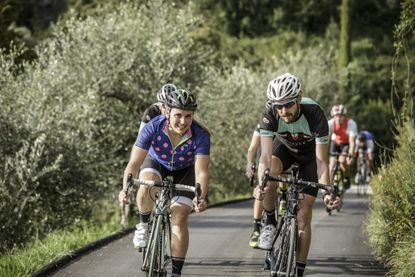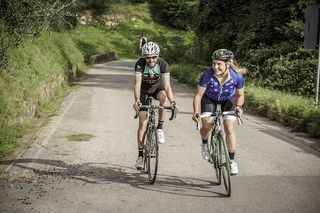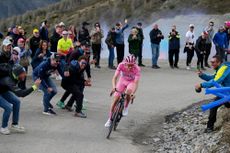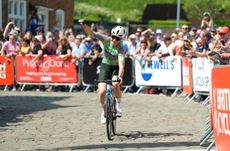Cycling and gender: how and why male and female cyclists need to train differently
Physiological differences mean different training programmes depending on your sex

Women and men have very different training needs

The biggest single difference in sporting performance separating one cyclist from another is gender. Since 1983, when the gender gap stabilised in Olympic sports, there has been a consistent average difference across all sports of around 10 per cent.
In track cycling, Dutch researchers found an average speed discrepancy of 12.6 per cent; the figure from similar German research was 11 per cent. On the roads, world and US masters’ records show the difference in the 25-mile TT is around 10 per cent.
The most obvious place to search for an explanation of this difference is in our physiology. However, very little sports science research is undertaken on women. This is partly because hormonal fluctuations mean you need a greater number of female subjects to obtain reliable results. We have a large gap in our collective understanding of how sex-related characteristics affect performance.
Drawing comparisons is also difficult; among women athletes, rarely are we comparing like with like. Body size is just one important difference with huge variation, and other physiological variables must be scaled accordingly. This presents challenges to science.
Jamie Pringle, a physiologist who has coached many world and Olympic champions, says: “The most consistent observation about the difference is that women have lower total mass of haemoglobin in their blood, compared to men, and less blood in total. This means less capacity to transport oxygen in the blood, which, when combined with the heart’s ability to pump that blood, and the muscle’s capacity to extract the oxygen from it, is a key determinant of aerobic fitness and endurance.”
>>> 11 of the best fitness upgrades you should try
According to Pringle, a well-trained female has about 10 to 12 per cent less haemoglobin for each kilogram of body mass compared to a male athlete. To test the impact of this difference, researchers had 10 male cyclists donate approximately one litre of blood so that their haemoglobin levels matched those of the study’s 10 female participants.
Get The Leadout Newsletter
The latest race content, interviews, features, reviews and expert buying guides, direct to your inbox!
Three days later, the riders undertook a VO2 max test and a performance trial: the men’s VO2 max values had fallen by seven per cent and their endurance capability was cut by around five per cent, indicating that haemoglobin accounts for at least half of the performance difference between the sexes.
Testosterone level is another important point of difference. Research published in the latest edition of the British Journal of Sports Medicine found that female athletes with higher levels of testosterone had a competitive advantage of up to 4.5 per cent over rivals with typical levels. Other differentiators include the amount of oxygen used per watt of power generated, and fat-burning capacity.

Dr Adam Simon, the chief medical officer at Push Doctor, says: “Men tend to be more muscular and have heavier bones, whereas women naturally have more body fat.”
The body fat issue is important because, to climb well, it is advantageous to have low body fat. For a female athlete, having very low body fat risks both their bone and reproductive health.
In assessing how these sex-related differences affect trainability and adaptation to exercise, science has much more work to do.
“Human performance is far too complex to be attributable to isolated genes,” says Pringle. “It will be a while until this physiological photograph develops.”
Nonetheless, some studies on nutrition have found that gender has an impact on optimal hydration; and men have been found to respond better then women to carb-loading.
>>> Do cyclists really need to carb-load before a big ride?
Developments in genomics are likely to uncover many more differences between the sexes. In a recent study comparing the physical traits of mice, at the Wellcome Trust Sanger Institute in Cambridge, researchers found that sex affected nearly 60 per cent of quantitative traits such as bone mass and 10 per cent of qualitative traits such as head shape.
Sex was also seen to influence the switching on and off of certain genes, a finding that has implications for disease treatment and possibly, one day, individualised training.
Studying the ageing process also helps explain the impact of physiological differences between the sexes. Before puberty, girls and boys show similar red blood cell profiles; the differences emerge only after menstruation begins. Girls’ body fat levels increase while boys gain muscle mass and their testosterone levels increase. Importantly for cyclists, males end up with higher lean leg volume.
At the older end of the scale, a US study found women’s performances in the 25-mile TT declined faster as they aged; the drop-off steepened from 9.5 per cent at 40 to 16.6 per cent at 50.
These differences could be down to the menopause, which, explains Simon, “causes lots of symptoms that are unhelpful for a woman’s cycling performance. The arrival of hot flushes means that blood has a tendency to head for the surface of the skin rather than the muscles where it’s needed. Hormonal changes mean that building and maintaining muscles becomes harder and, to complete the double whammy, it becomes harder to stay lean.”
The key difference pre-menopause is menstruation. Georgia Bruinvels, a PhD researcher at UCL, found that 41.7 per cent of female athletes felt their menstrual cycle affected their performance. The effects include increased injury risk from hormonal changes, having to deal with pain and cramps, and of course monthly loss of blood, potentially resulting in iron deficiency.
>>> How to set your saddle height: calculate the perfect position
The physiological differences, largely limiting power rather than endurance, suggest the gender performance gap should reduce as the distances increase. Male traits — more fast-twitch fibres, more haemoglobin and therefore higher V02 max — are less advantageous in ultra-endurance events. In fact, certain female traits become advantageous.
“In cycling, it pays to be aerodynamic,” says Pringle. “A typically smaller-framed female athlete is more aerodynamic and lighter in the hills.”
Ultra-distance cyclist Jasmijn Muller agrees: “Whereas over shorter distances males’ larger muscles may help with sprinting efforts, they also fatigue more quickly. Women can keep going for longer on less fuel, as they have proportionally more fat, which burns more slowly than carbs.”
Over longer distances, mental strength and competitiveness can prove decisive, and Muller believes women have the edge in this regard too. “The longer the race, the more mental a game it becomes. Women are built for labour, which is after all a very painful endurance feat. A high tolerance to pain, and a strong desire to prove that we can perform as well as men in ultra races, can get you a long way.”
Are there really psychological differences between men and women? Sports psychology rarely finds major differences in terms of personality traits or mental skills, but interesting findings have been made relating to confidence. Broadly, female athletes have been shown to display higher levels of anxiety.
Of course, it’s hard to determine whether this higher anxiety is down to genetics or environment (including social factors), or a combination of the two. It could be that attitudes around cycling — e.g. the presumption that men are ‘naturally’ more competitive — have a persistent, widespread effect. Social elements are clearly important, as they can affect confidence and anxiety — and even, for women, whether they choose to ride bikes in the first place.
Watch: Can cycling improve your sex life?
Far fewer women than men race bikes: only 18 per cent of British Cycling licence holders are female. Some of the average difference in performance inevitably comes down to participation levels: greater numbers mean raised competitiveness — the performance bar is pushed higher. There have been standalone exceptional female cyclists, such as Beryl Burton, but could such women have performed even better in stacked fields with close rivals snapping at their heels?
Muller says she would love to see more women challenging her. “It creates a great atmosphere, and competition spurs you on to go faster and really be your best. I love racing in long-distance time trials where I know some of my key female rivals will be competing. In 2015, Jill Wilkinson and I battled it out over 12 hours, with me taking the win by a mere 192 metres.”
The UK government is currently trying to increase female participation across all sports. A recent survey for Women’s Sports Week found that while 83 per cent of sports now pay equal prize money, cycling is in the minority that does not. Coryn Rivera received €1,100 for winning the women’s Tour of Flanders, whereas Philippe Gilbert netted €20,000 for winning the men’s version.
When wages and sponsorship are added into the mix, the disparity widens. Why would parents encourage their daughter into a sport that values her race-winning talent, skills and time as worth only one 20th of a man’s?
The second-class culture isn’t just about money. It is about wider support. The way cycling is set up, from UCI level downwards, means that female athletes receive less technical help, have to make do with less advanced equipment, and often miss out on physiological or psychological support.
>>> How elite riders combine high level racing with full-time jobs
Most elite female athletes — unless they are on the GB programme — have to work full-time and squeeze in their training on top.
Even the timing of events means that the big crowds or TV coverage are reserved for the men’s races, which creates a very different race environment. Only a few weeks ago at the Irish National Road Race Championships, the female peloton was pulled over and made to wait for the men’s race to pass.
Add into this dubious mix a cycling culture that still features podium girls, objectifying marketing tactics, a ‘pink it and shrink it’ attitude to female kit, and high-profile claims of sexism (revealed in recent reports and rider autobiographies) — is it any wonder cycling is failing to attract women?
So, on average, male riders are stronger and more powerful. They have more blood carrying more oxygen, less fat, and more fast-twitch fibres. And they can train unrestricted by menstrual cycles and attendant fluctuating hormone levels.
As distances lengthen, these physiological differences become less important, yet there remains a persistent gender gap. There are problems with the culture of the sport and low participation levels among women.
To reduce the performance gap, we need to move away from thinking of female athletes as ‘little men’ and instead design training that optimises their physiology. At the same time, we need to take a long, hard look at the culture in cycling to ensure we treat cyclists equally, whatever their gender.
Train to suit your sex
Male and female athletes, because of the differences in their physiology, sometimes need to train differently. Georgia Bruinvels, a research scientist at analytics specialist Orreco, and Level 3 coach Holly Seear of Spring Cycling Coaching, explain.
Muscle development
Men develop more fast-twitch fibres than women. Women don’t naturally use their posterior chain, activate their core and glutes as much as men. Female athletes are more quad-dominant and develop muscle more slowly.
Female athletes should therefore do more core and glute activation and more specific acceleration work. Males can pick certain times of the year for strength training, while allowing their legs to feel fresher during race season.
Hormones
Men benefit from higher levels of testosterone, which help to build muscle and bone mass. Women need many hormones working in unison for menstrual cycles. And everyone relies on the healthy levels of metabolic hormones such as adrenalin and insulin.
Female athletes need to spot the patterns because at different times of the month different proportions of glycogen and fats are needed to fuel training, sweat responses, core temperature and blood plasma volume — and can even affect emotional response. It is therefore important for women to time training sessions accordingly, as well as paying particular attention to diet.
Male athletes need to be aware that testosterone levels can fall as they age, which can have an impact on their cycling through loss of muscle mass, fatigue, increased body fat and decreased bone mass. A blood test can check your levels.
Periodisation
The menstrual cycle increases the likelihood of cramping at certain times of the month. Female athletes should follow a four-week training cycle with three weeks’ hard training followed by a recovery week.
Male athletes can have more flexibility about how often they take easier weeks for recovery to fit in with their racing plans.
Injury risk
Again, the menstrual cycle can raise injury risks for females, who should, during ovulation, enhance their warm-up, be cautious with short, sharp efforts, and maximise recovery by fuelling correctly and smartly.
Male athletes have been found to be more prone than females to ignoring niggles, which can turn into full-on injuries.

Thank you for reading 20 articles this month* Join now for unlimited access
Enjoy your first month for just £1 / $1 / €1
*Read 5 free articles per month without a subscription

Join now for unlimited access
Try first month for just £1 / $1 / €1
Dr Josephine Perry is a Chartered Sport and Exercise Psychologist whose purpose is to help people discover the metrics which matter most to them so they are able to accomplish more than they had previously believed possible. She integrates expertise in sport psychology and communications to support athletes, stage performers and business leaders to develop the approaches, mental skills and strategies which will help them achieve their ambitions. Josephine has written five books including Performing Under Pressure, The 10 Pillars of Success and I Can: The Teenage Athlete’s Guide to Mental Fitness. For Cycling Weekly she tends to write about the psychological side of training and racing and how to manage mental health issues which may prevent brilliant performance. At last count she owned eight bikes and so is a passionate advocate of the idea that the ideal number of bikes to own is N+1.
-
 'Who TF flagged me?': Tadej Pogačar's achievement marked as questionable on Strava after Giro d’Italia stage victory
'Who TF flagged me?': Tadej Pogačar's achievement marked as questionable on Strava after Giro d’Italia stage victoryThe queen stage of race featured the brutal Mortirolo pass and included more than 5,400 metres of elevation
By Tom Thewlis Published
-
 'UK riders deserve something to aim for' - British women's team aims to join pro ranks in 2025
'UK riders deserve something to aim for' - British women's team aims to join pro ranks in 2025British Continental squad Lifeplus-Wahoo hope to mark 10-year anniversary with ProTeam status
By Tom Davidson Published